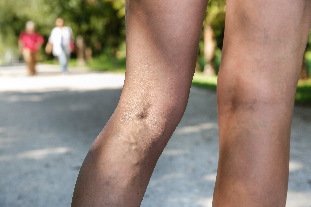Varicose veins (varicose veins) is a chronic disease that is characterized by a bumpy veins with violation of the outflow of blood and its stagnation in the venous system.
The first veins do not cause discomfort and is just one reason for the cosmetic defect: the appearance of translucent through the skin, knotted veins, blue-brown shade.

Symptoms of varicose veins
You need to go to phlebologist, if you think that you have at least one of the following symptoms of varicose veins:
- translucent through the skin tortuous veins of the legs;
- feeling of weight in legs, fatigue;
- irregular brown pigmentation of the skin of the feet and ankles;
- constant pain in the legs;
- swelling of the feet and legs, which usually appear after prolonged standing or sitting with drooping feet;
- sporadic cramps in the muscles of the lower limbs;
- in the later stages of the disease – ulcers on the skin or in the joints.
Noticing the first signs of vein disease, don't hesitate and immediately consult a specialist-a phlebologist. The latest diagnostic equipment to get rid of varicose veins that allows experienced doctors to identify the disease at an early stage and prevent complications.
The main reasons for the appearance of varicose veins
To veins often be brought:
- congenital weakness of the venous wall, which predisposes for the development of varicose veins and is inherited;
- gender – women suffer from varicose veins of the legs two times more often than men. According to one theory, this is due to wearing high heels;
- long to stay on the feet. Varicose veins often affect people whose profession is connected with work of feet: sellers, teachers, hairdressers, and others;
- age – varicose veins frequently develop after age 45;
- the lack of exercise, work, long stay standing or sedentary way of life;
- excessively intense physical activity;
- obesity and excessive weight.
Stage of varicose veins
Stage 1 – the stage of compensation. Manifestations of venous insufficiency is not. Worried about the discomfort and fatigue of the legs.
Phase 2 – phase subcompensation. There are pain, veins begin to bulge under the skin, in the form of nodes.
Stage 3 – the stage of decompensation. Are characterized by a marked disturbance of the outflow of blood from the lower limbs, the development of trophic disorders of the skin, possible formation of nonhealing venous ulcers.
The clinic for the treatment of varicose veins, should be applied when symptoms first stage – it will be easier and faster to get rid of the disease and to prevent the development of complications.
Complications of varicose veins
Lipodermatosclerosis \ white atrophy of the skin
Lipodermatosclerosis is a fibroid degeneration of the skin and subcutaneous fat. Tissues lose their elasticity and mobility. An extreme form of lipodermatosclerosis white atrophy of the skin.
Venous eczema / dermatitis
Eczema occurs in the later stages of varicose veins and is the inflammation and redness of the skin of the feet. With the progression of varicose deteriorates the nutrition of the skin, which ultimately leads to the emergence of trophic ulcers.

Acute thrombosis venous
The basis of this complications of varicose veins – the formation of a blood clot (thrombus) in the deep veins of the legs, which with the flow of blood can enter the heart or lungs. The condition requires immediate medical attention!
Thrombophlebitis
Thrombophlebitis – inflammation of vein wall with thrombus formation, closure of the lumen of the vessel. In most cases, thrombosis is the result of "running" forms of varicose veins.
Trophic ulcer
This long-term treatment of the skin defect developing on the background of venous congestion requires a comprehensive treatment.
Bleeding from varicose veins
Bleeding most often occurs because of trophic venous ulcers, however, may be from the veins. First aid for bleeding varicose veins: it is necessary to impose a pressure bandage directly to the site of bleeding, raise the limb above the horizontal level, and then requires hospitalization.
Prevention of varicose veins
In order never to deal with varicose veins, you must to:
- avoid prolonged standing or sitting; to give up the habit of sitting for long periods of time in the position of the feet;
- to prevent the appearance of extra pounds;
- regularly engage in physical activity (fitness, swimming, etc.);
- to choose comfortable shoes, try to not wear shoes with heels every day.
The treatment of varicose veins
Today, the removal of varicose veins in the legs occur most often without traumatic interventions, as it was 10-15 years ago. Recovery treatment takes a minimum of time!




































